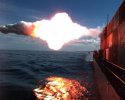With the improvements to existing weapons, and with the new developments, the US Navy has, or soon will have all of the following anti-shipping missiles availabe to them...either for launch from ships and submarines, or from aircraft:
Maverick (AGM-65) - Video, IR, and Laser guidance. 25 km range.
JDAM (LJDAM-ER) - With Inertial, GPS, and Laser guidance. In flight direction. 80 km range.
HARM (AGM-88E) - Inertial, GPS, Passive/Active Radar, Home-on-jam guidance. 125 km range.
Standard Missile (RIM-67) - Inertial, Infrared, and semi-radar homing guidance. 190 km range.
SLAM-ER (AGM-84H/K) - Inertial, GPS and IR guidance with in flight direction. 270 km range.
Harpoon Block II- (R/A/UGM-84E/F) - Active Radar Homing guidance. In flight direction 275-300 km range.
JASSM-ER (AGM-158) - Inertial, GPS guidance. 1,000 km range.
Tactical Tomahawk (R/A/UGM-109) - Inertial, GPS, TERCOM, DSMAC guidance. In flight direction. 1,700 km range.
Under development, already tested and soon to be in production:
Joint Stike Missile (JSM) - Inertial, GPS, Terrain Comparison, and IR guidance. In flight direction 280 km range.
Long Range Anti-shipping Missile (LRASM) - Inertial, GPS, IR, Radar homing. In flight direction. 370 km range.
Maverick (AGM-65) - Video, IR, and Laser guidance. 25 km range.
JDAM (LJDAM-ER) - With Inertial, GPS, and Laser guidance. In flight direction. 80 km range.
HARM (AGM-88E) - Inertial, GPS, Passive/Active Radar, Home-on-jam guidance. 125 km range.
Standard Missile (RIM-67) - Inertial, Infrared, and semi-radar homing guidance. 190 km range.
SLAM-ER (AGM-84H/K) - Inertial, GPS and IR guidance with in flight direction. 270 km range.
Harpoon Block II- (R/A/UGM-84E/F) - Active Radar Homing guidance. In flight direction 275-300 km range.
JASSM-ER (AGM-158) - Inertial, GPS guidance. 1,000 km range.
Tactical Tomahawk (R/A/UGM-109) - Inertial, GPS, TERCOM, DSMAC guidance. In flight direction. 1,700 km range.
Under development, already tested and soon to be in production:
Joint Stike Missile (JSM) - Inertial, GPS, Terrain Comparison, and IR guidance. In flight direction 280 km range.
Long Range Anti-shipping Missile (LRASM) - Inertial, GPS, IR, Radar homing. In flight direction. 370 km range.
Last edited:




